To view previous releases, select one from the dropdown box:
Currently displaying information released on: May, 2024
ANALYSIS OF CONSUMER PRICE INDEX FOR APRIL 2024
Nova Scotia’s all items Consumer Price Index (CPI) slowed to 3.1% year-over-year in April 2024, down from 3.3% year-over-year in March. This was the fastest year-over-year pace of price growth across provinces.
Nova Scotia's inflation has been slowing after peaking at 9.3% in June 2022, though there have been periods of rising inflation, particularly on higher energy prices.
Nationally, consumer prices increased 2.7% year-over-year in April 2024, down from 2.9% in March. Inflation was highest in Nova Scotia and slowest in Manitoba.
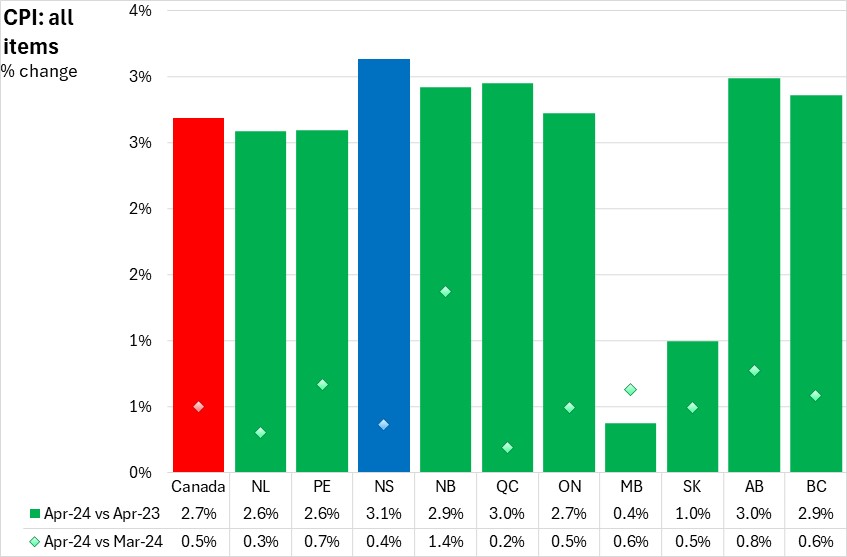
The most significant upward contributors (combining price increase as well as share of the consumption basket) to Nova Scotia's 3.1% year-over-year inflation were: rent, mortgage interest cost, gasoline, fuel oil and food purchased from restaurants.
The largest downward year-over-year contributions were from: telephone services, men's clothing, homeowners replacement cost, recreational equipment and services (excluding RVs), and traveller accommodation.
On a monthly basis, Nova Scotia's all items CPI was up 0.4% from March to April 2024. National prices were up 0.5% with increases reported for all provinces. New Brunswick reported the fastest percentage growth on a monthly basis. Québec reported the slowest monthly increase.
Major upward contributors to Nova Scotia's monthly consumer prices were: gasoline, rent, health care services, food purchased from restaurants and sugar/confectionery. The main downward contributions were from: travel tours, recreational equipment and services (excluding RVs), fuel oil, traveller accommodation and inter-city transporation.
Energy prices play a significant role in inflation rates. Nova Scotia's energy prices were up 8.5% from April 2023 to April 2024. Year-over-year energy prices were up 4.5% nationally with eight provinces reporting higher energy prices. Nova Scotia reported the fastest year-over-year growth in energy prices while Manitoba reported the largest decline.
On a monthly basis, Nova Scotia's energy prices increased 3.2% from March to April 2024. National energy prices were up 5.1% with all provinces reporting higher prices compared to the previous month. New Brunswick reported the largest monthly increase in energy prices, while Saskatchewan posted the smallest monthly increase.
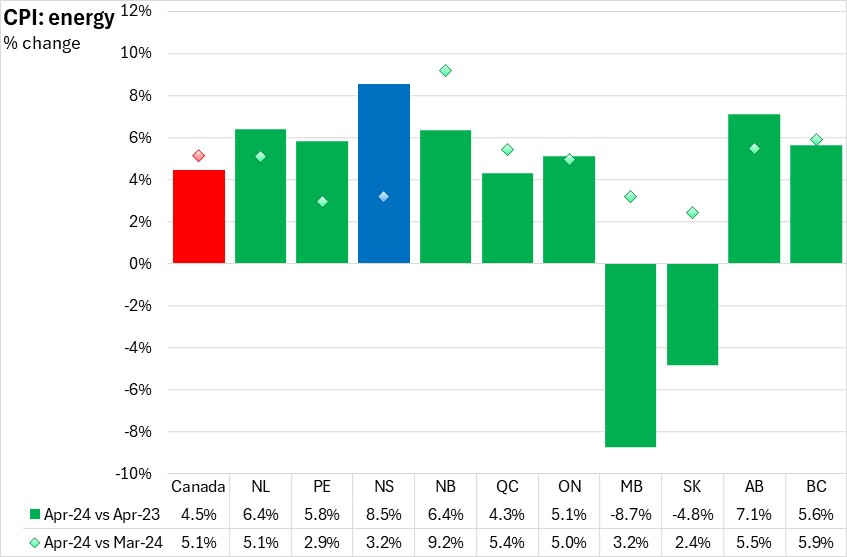
Nova Scotia's energy prices (and overall inflation) are more sensitive to fluctuations in the global price of crude oil. In April 2024, gasoline prices increased 8.8% compared to a year ago in Nova Scotia. Eight provinces reported higher gasoline prices, with the fastest growth in Alberta (followed by Nova Scotia). Manitoba reported the steepest drop in gasoline prices. Gasoline prices increased 7.6% from March to April in Nova Scotia (+7.9% nationally). All provinces reported monthly gasoline price increases with the largest rise in New Brunswick.
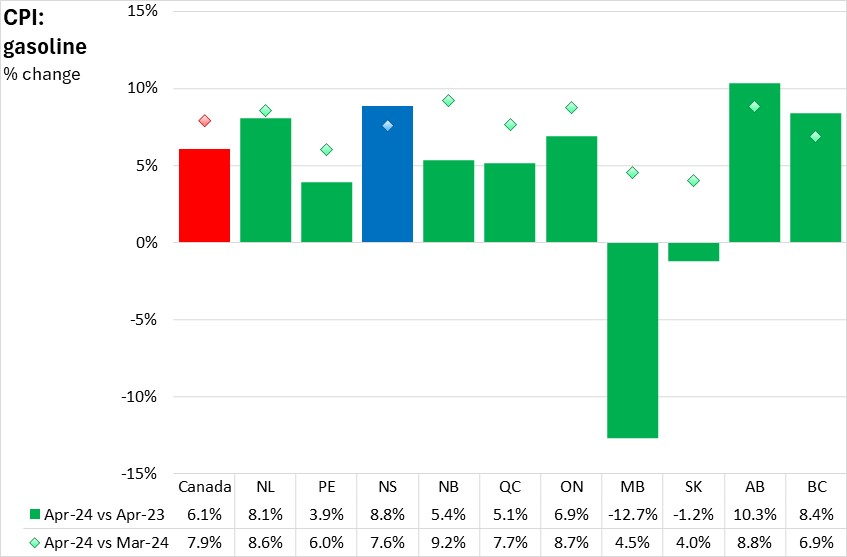
Nova Scotia's year-over-year inflation for fuel oil was 11.5%, the second fastest growth among provinces. Nationally, the fuel oil and other fuels index increased 3.2% compared to April 2023. On a monthly basis, Nova Scotia's fuel oil prices were down 4.1%. National fuel oil prices were down 1.4% from March to April.
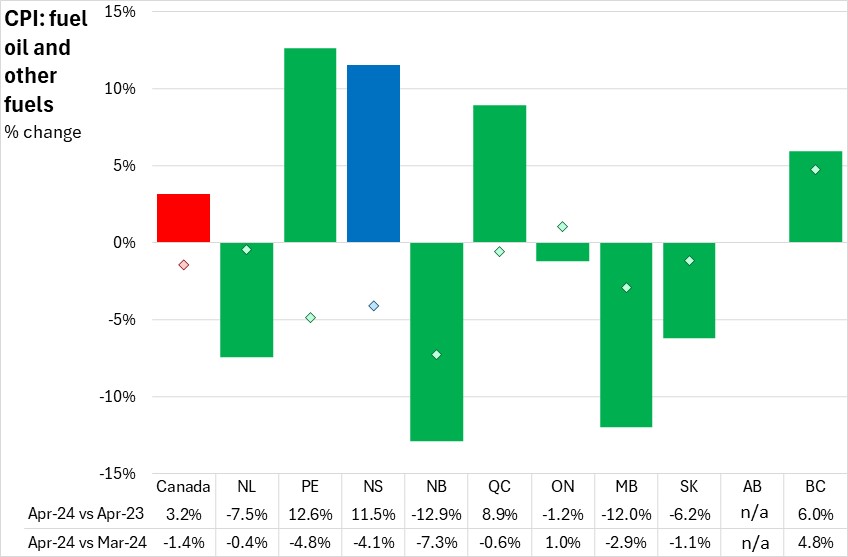
Food price inflation was 3.2% in Nova Scotia (April 2024 vs April 2023). National food prices increased 2.3% in April. Food prices were up in all provinces. Prince Edward Island reported the highest food price inflation while Manitoba reported the slowest food price growth. Nova Scotia was the only province to report acceleration in year-over-year food price inflation in April 2024.
On a monthly basis, Nova Scotia's food prices increased 0.5% from March to April. National food prices declined 0.2% with 6 provinces reporting lower prices on a monthly basis. The fastest growth was in Nova Scotia while Manitoba and British Columbia reported the largest monthly declines.
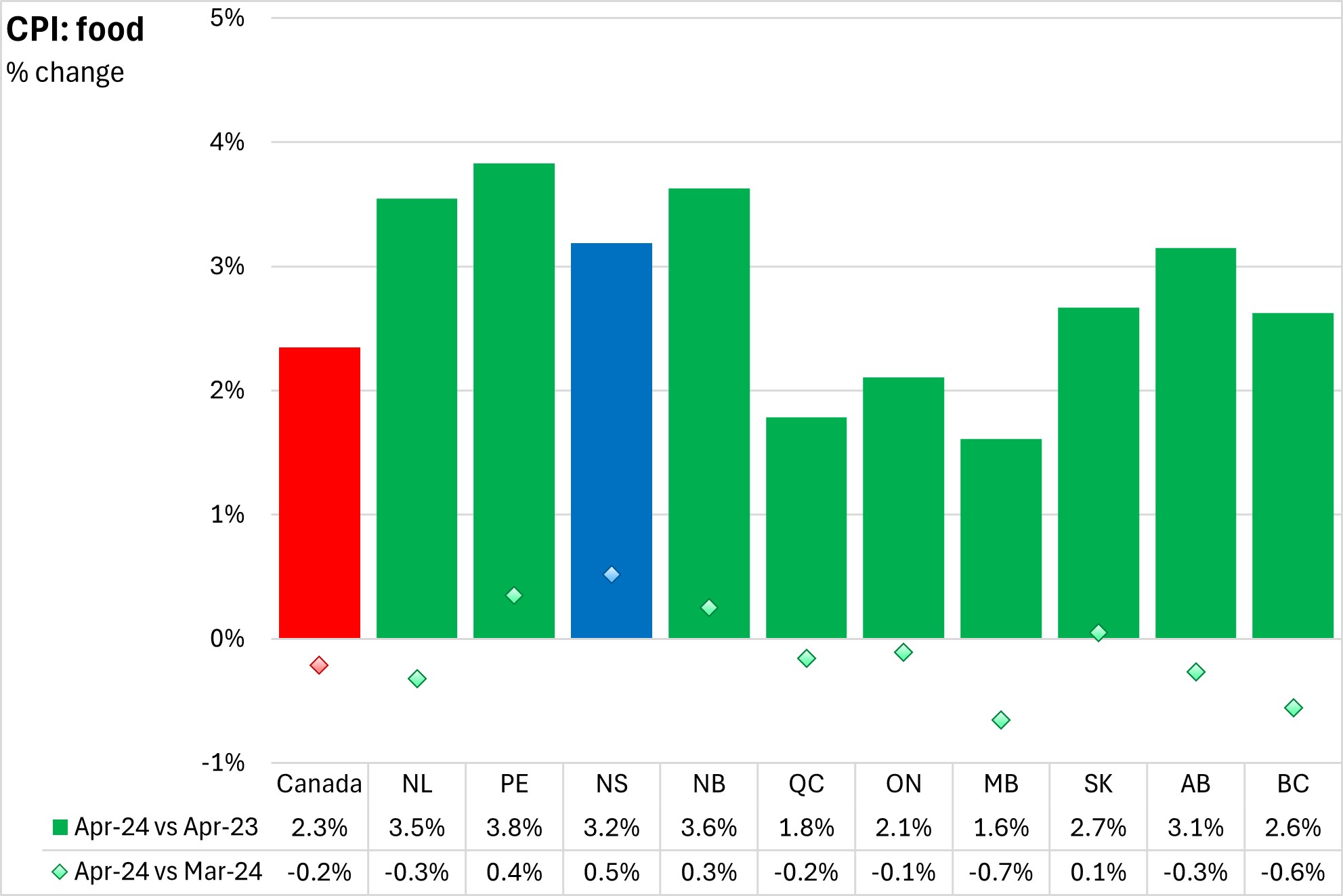
Food and energy prices are heavily influenced by volatile global commodity markets. Nova Scotia's underlying inflation rate excluding food and energy was 2.4% from April 2023 to April 2024. Nationally, inflation excluding food and energy was 2.7%. Québec reported the fastest growth while Manitoba reported the slowest growth in inflation excluding food and energy prices.
On a monthly basis, Nova Scotia's prices for all items excluding food and energy were down 0.1% from March to April 2024. Nationally, prices for all items excluding food and energy were up 0.3% with increases in 7 provinces. Manitoba reported the fastest monthly increases while Newfoundland and Labrador reported the largest drop.
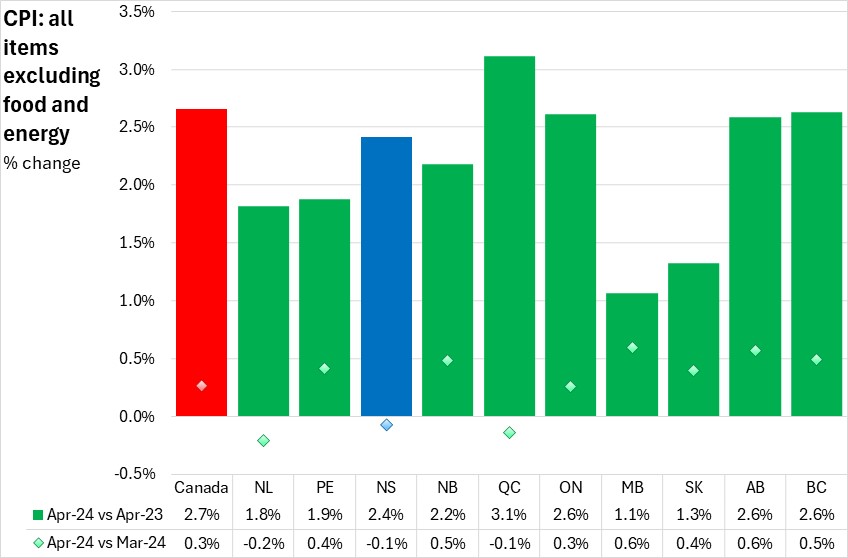
Year-over-year shelter cost inflation was 6.8% in Nova Scotia in April 2024, slightly below the 6.9% shelter inflation reported in March. National shelter prices were up 6.4% with increases in all provinces. Alberta reported the largest year-over-year increase in shelter prices while Saskatchewan reported the slowest increase.
Monthly shelter costs were up 0.1% in Nova Scotia from March to April 2024. Nationally, shelter costs were up 0.5% with increases in all provinces. New Brunswick reported the fastest monthly growth in shelter prices and Nova Scotia reported the slowest growth.
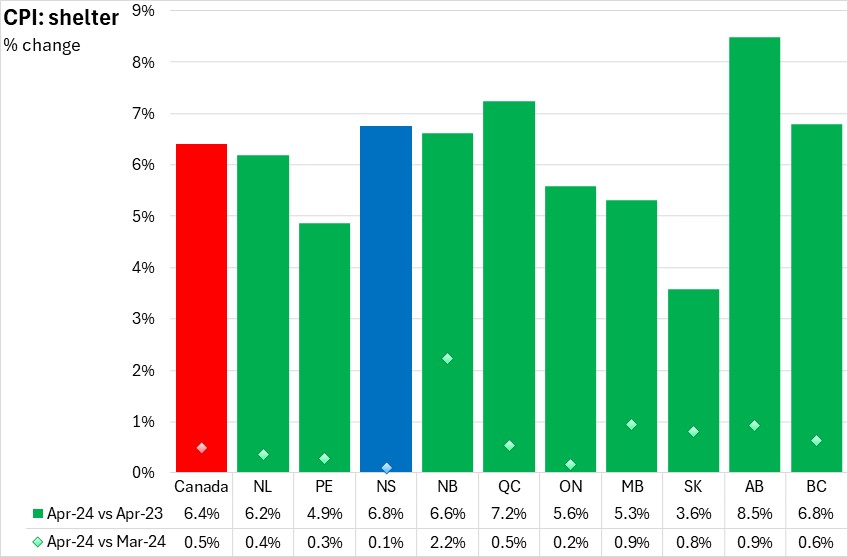
Among detailed food products with available data, Nova Scotia's year-over-year inflation was fastest for sugar and confectionary as well as preserved fruit. The largest year-over-year price decline was for butter.
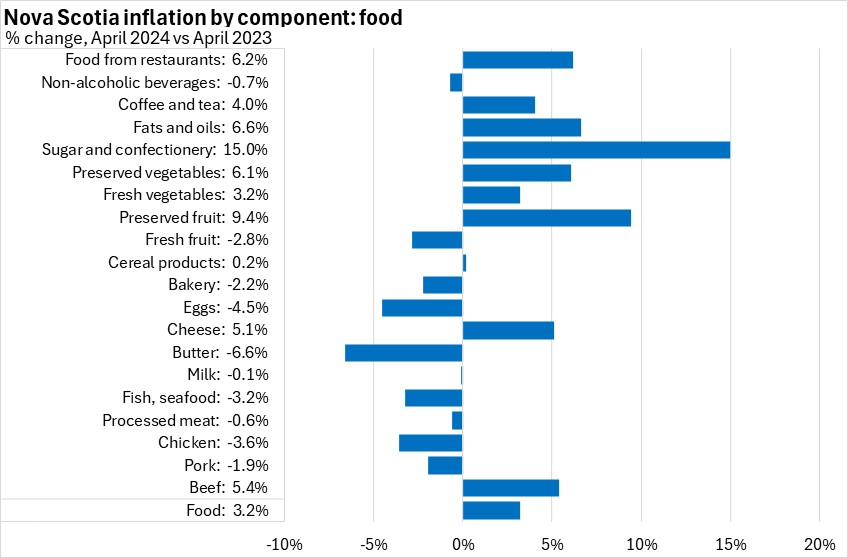
In detailed shelter cost components, fuel oil reported the fastest year-over-year price increase, followed by home and mortgage insurance and rent. Homeowners replacement cost reported the only year-over-year decline.
Household operations/furnishings costs were down 0.5% overall. Prices fell for telephones, paper/plastic/aluminium products as well as for utensils/tableware/cookware. The largest increases were in internet access services.
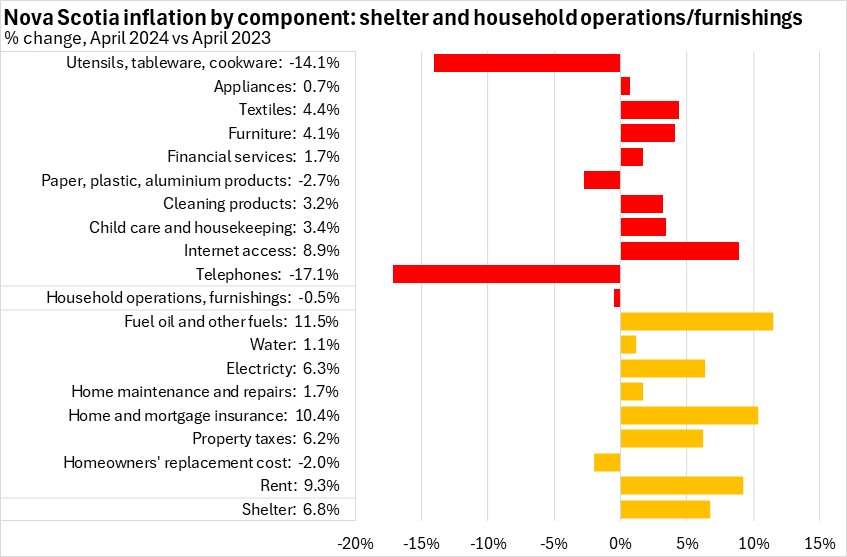
Clothing and footwear prices were down 5.4% year-over-year in April with declines in all sub-components except clothing materials and services.
Health and personal care costs were up 3.7% year-over-year on gains in all sub-components led by personal care services.
Overall transportations costs were up 3.3% year-over-year in April. City busses had the largest decline while gasoline had the largest increase.
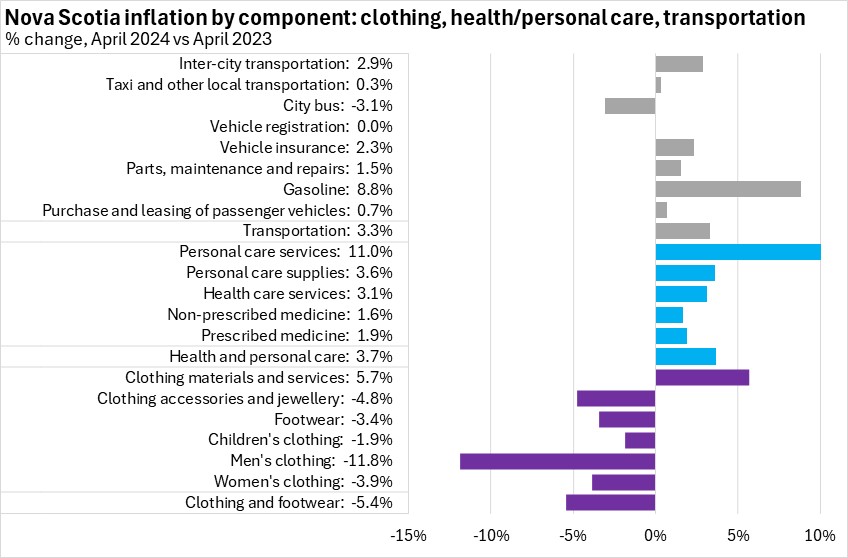
Nova Scotia's overall prices for recreation, education and reading were up 1.4% from April 2023 to April 2024, with faster increases for travel services/accommodations. Prices declined the fastest for recreational equipment/services (excluding RVs) as well as for home entertainment equipment/services compared to April 2023.
Nova Scotia's prices for alcohol, tobacco and recreational cannabis were up 3.9% year-over-year with growth in all categories. Alcohol from licensed establishments had the largest increase, followed by cigarettes.
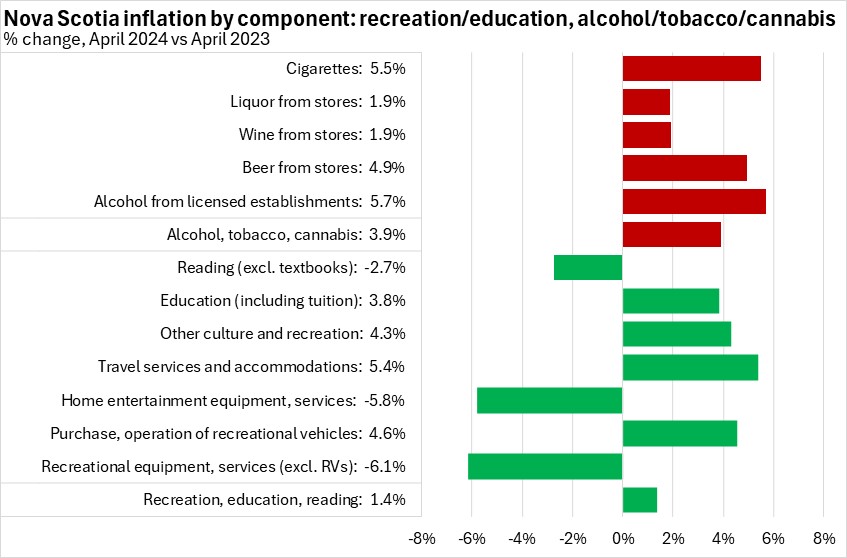
Trends
Since the start of the Bank of Canada's inflation-targeting monetary policy regime, inflation for all items has generally been in the 0-4% range. Periods of above target inflation are typically followed by periods of slow price growth or declines. The most recent acceleration in inflation was the strongest since the inflation-targeting era began, though this inflation has faded with tighter monetary policy and lower commodity prices.
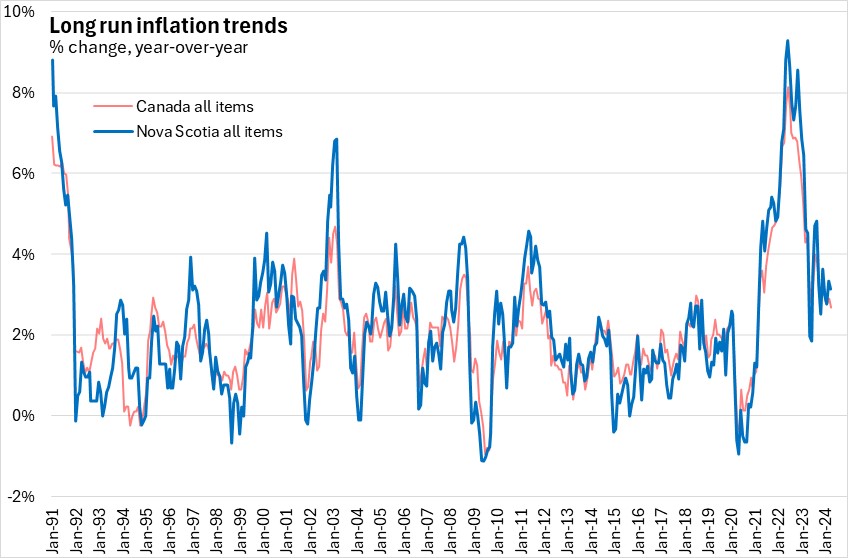
Many of these periods of accelerated and slowed inflation are attributable to volatile commodity prices, especially energy prices. Once the more volatile commodity prices are excluded, inflation in Nova Scotia has largely been below 2% for much of the last 20 years. However, the recent rise in inflation through 2021-2023 spreads beyond commodity prices, resulting in the longest period under the Bank of Canada's inflation-targeting regime with Nova Scotia's CPI excluding food and energy above 3%. In the last four months, Nova Scotia's inflation excluding food and energy has slowed to less than 3% year-over-year.
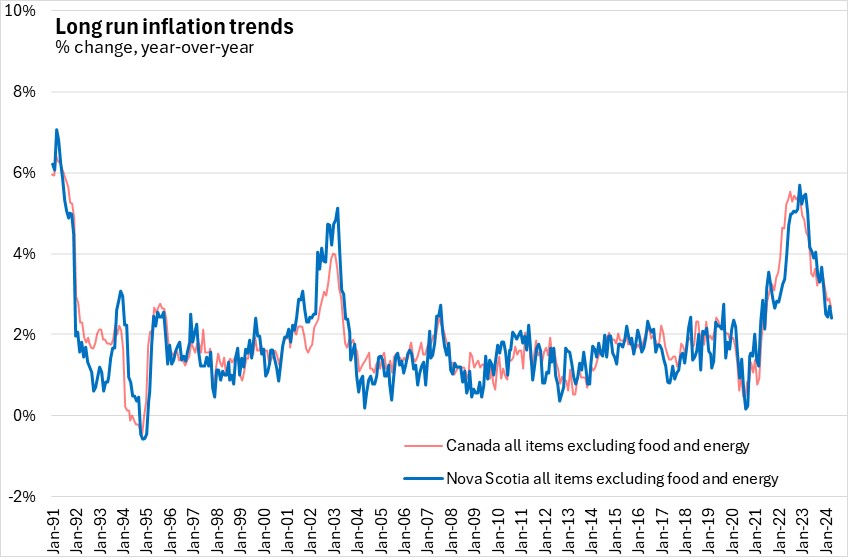
The Bank of Canada examines 'core' measures of inflation that are intended to remove the effects of volatile components and capture underlying inflation trends that are more connected to capacity in the Canadian economy. Core measures of inflation may also indicate where all items inflation is headed.
Canada's core measures of inflation remained mostly at or below the Bank's target of 2% for over a decade prior to 2021. However, after prices accelerated in 2022, core inflation measures also started to rise, peaking at over 6% for the CPI-common measure before declining. Compared to the previous month, year-over-year core inflation measures in April 2024 were down for all core measures: CPI-common (2.6%), CPI-median (2.6%), CPI-trim (2.9%), CPI-core (1.6%).
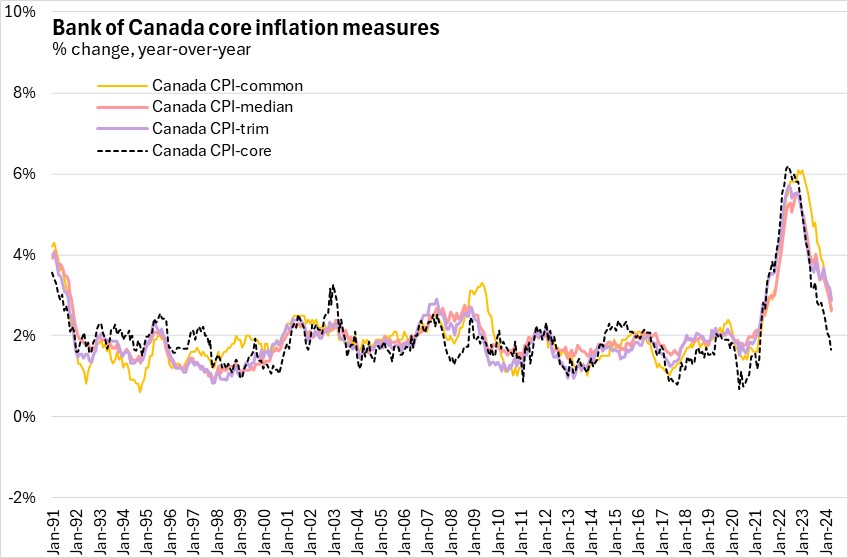
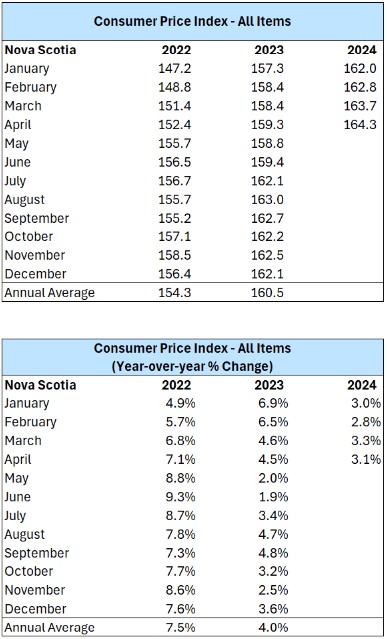
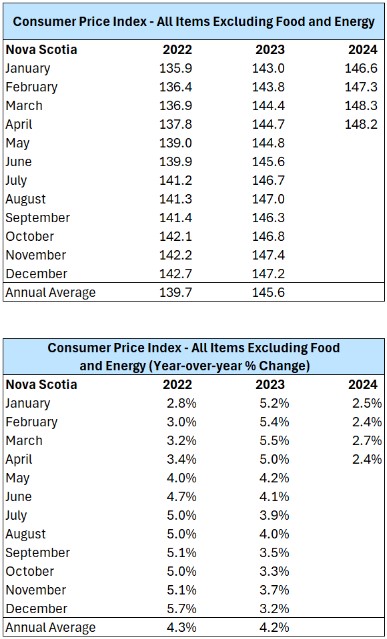
 Source: Statistics Canada. Table 18-10-0004-01 Consumer Price Index, monthly, not seasonally adjusted; Table 18-10-0256-01 Consumer Price Index (CPI) statistics, measures of core inflation and other related statistics - Bank of Canada definitions Source: Statistics Canada. Table 18-10-0004-01 Consumer Price Index, monthly, not seasonally adjusted; Table 18-10-0256-01 Consumer Price Index (CPI) statistics, measures of core inflation and other related statistics - Bank of Canada definitions
CONSUMER PRICE INDEX, APRIL 2024
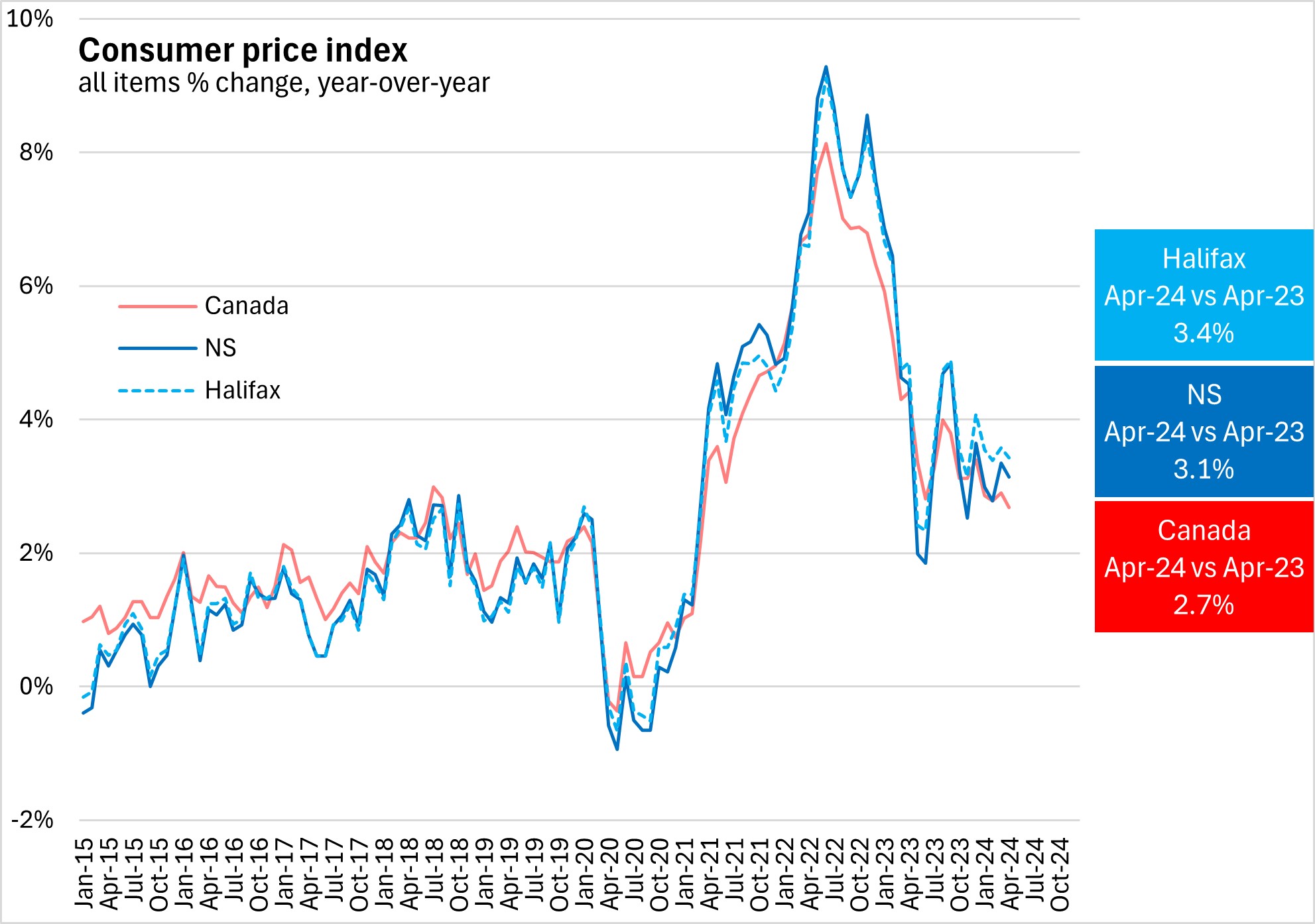
Year-over-year (April 2024 vs April 2023)
All items: Consumer prices in Nova Scotia increased 3.1%. The national average inflation was 2.7%. In Halifax consumer prices increased 3.4%.
All items excluding food and energy: Nova Scotia consumer prices outside of food and energy increased 2.4%. This was below the national average increase of 2.7%.
Month-over-month (April 2024 vs March 2024)
All items: Consumer prices in Nova Scotia increased 0.4%. Nationally, consumer prices increased 0.5% compared to the previous month. In Halifax consumer prices rose 0.4%.
All items excluding food and energy: Nova Scotia consumer prices excluding food and energy declined 0.1% month over month in April 2024. Nationally, consumer prices outside of food and energy were 0.3% higher compared to the previous month.
Source: Statistics Canada. Table 18-10-0004-01 Consumer Price Index, monthly, not seasonally adjusted EU AND EURO AREA CONSUMER PRICE INDEX, APRIL 2024
Year-over-year (April 2024 vs April 2023)
The inflation rate remained unchanged at 2.6% in the European Union and at 2.4% in the Euro Area in April 2024.
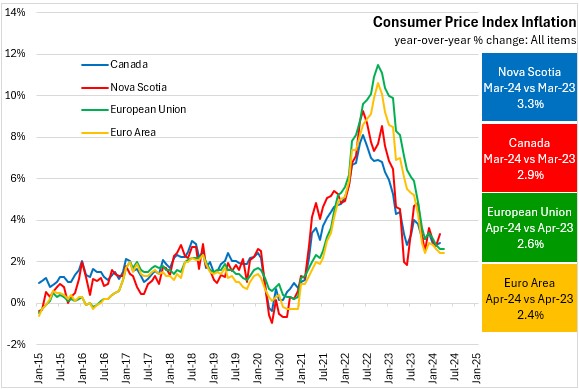
The fastest inflation was reported in Romania (6.2%) while the slowest inflation rates were in Lithuania and Denmark (0.4% and 0.5% respectively).
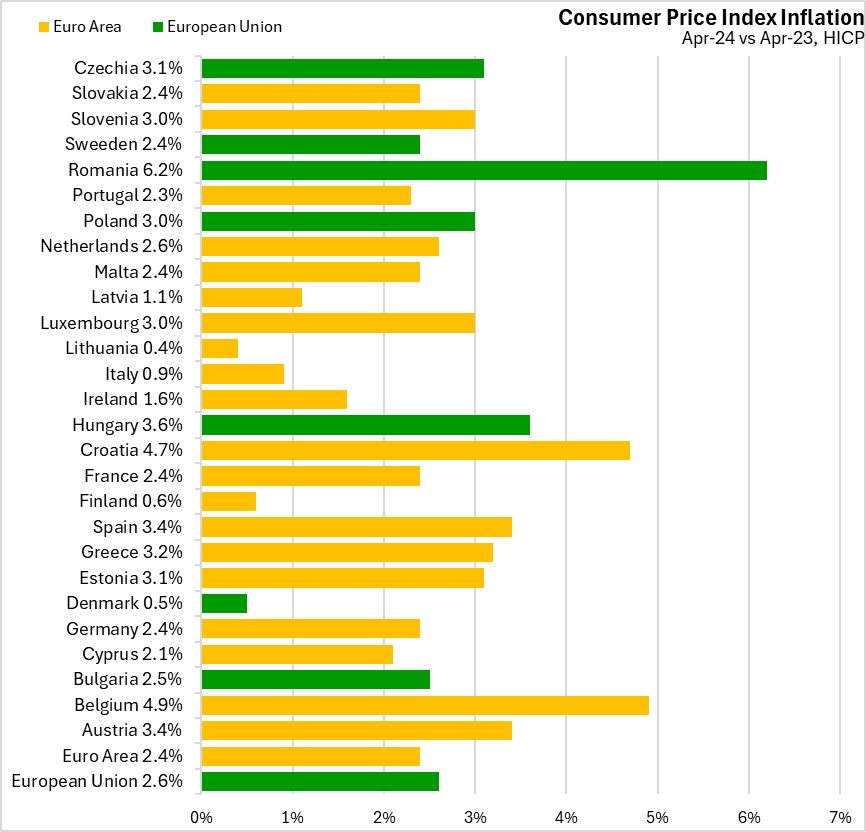
Energy prices declined 0.5% in the European Union and declined 0.6% in the Euro Area in April 2024.
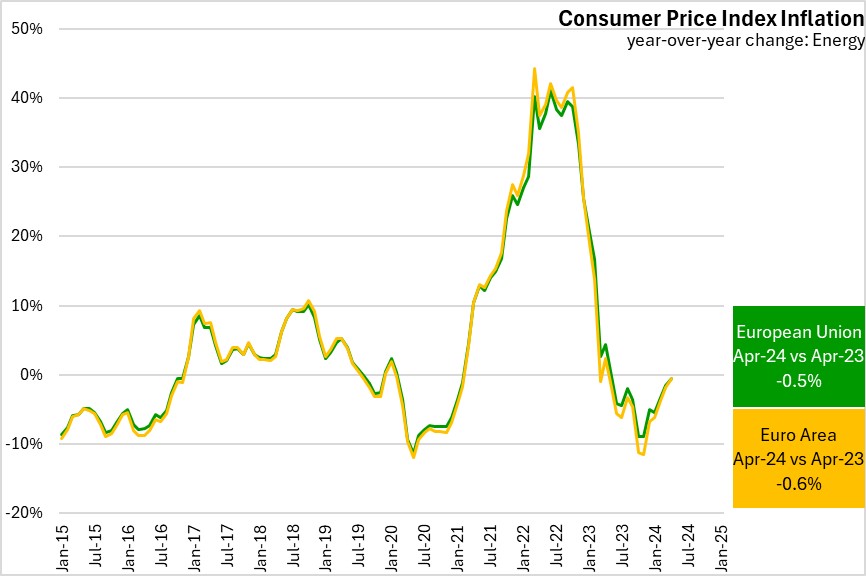
Food price inflation has continued to slow to 1.6% for the European Union and 1.9% in the Euro Area in April 2024.
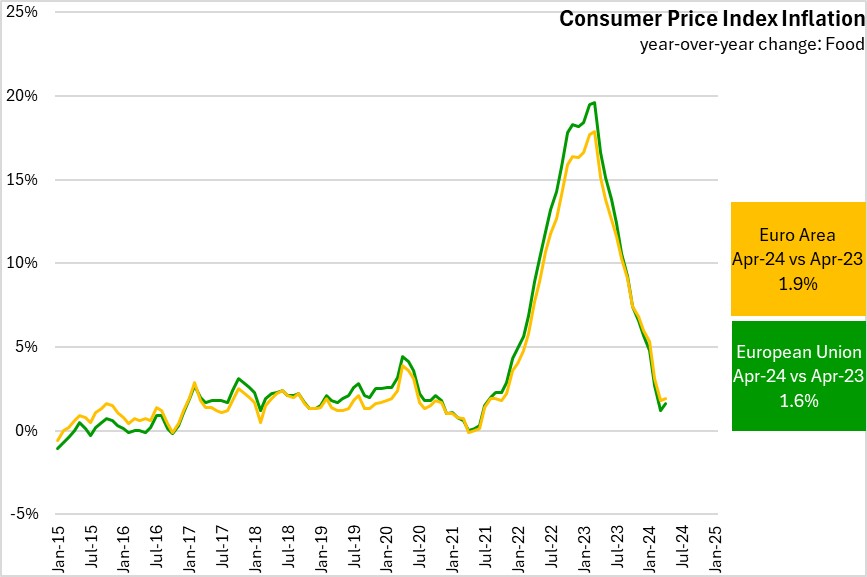
Excluding the impacts of energy, food, alcohol and tobacco prices year-over-year inflation was slowed to 3.0% in the European Union and 2.7% in the Euro Area in April 2024.
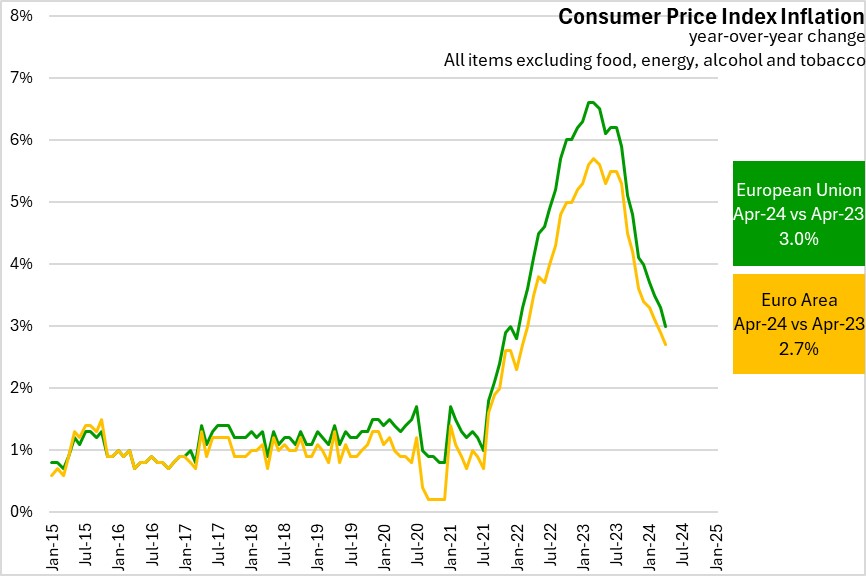
Source: Eurostat; Eurostat Data US CONSUMER PRICE INDEX, APRIL 2024
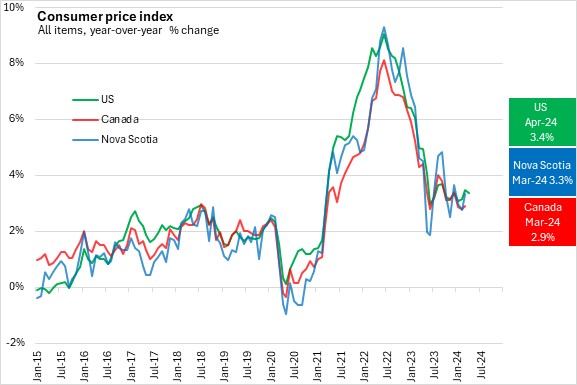 
The United States Consumer Price Index (not seasonally adjusted) for All Urban Consumers increased 3.4% year-over-year in April 2024.
Compared to April 2023, the US energy price index rose 2.6%. The food index rose 2.2% and the shelter index was up 5.5% year-over-year.
The US CPI excluding food and energy rose 3.6% compared to April 2023.
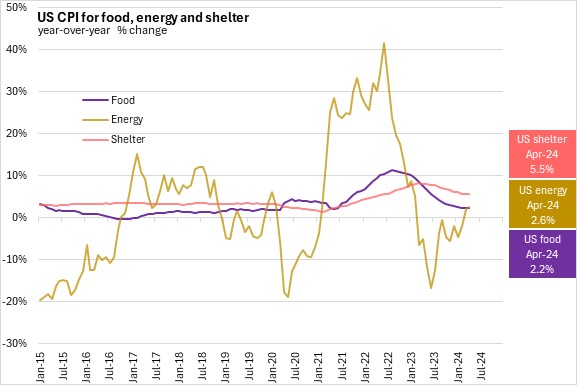
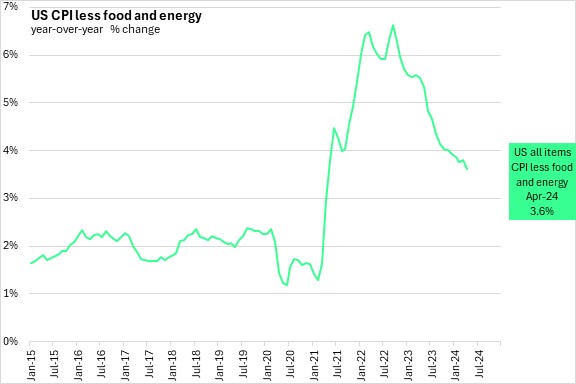
Note: Canada and Nova Scotia April 2024 CPI figures will be released on May 21, 2024.
Sources: Statistics Canada. Table 18-10-0004-01 Consumer Price Index, monthly, not seasonally adjusted; US Bureau of Labor Statistics retrieved from Federal Reserve Bank of St. Louis using the FRED API.
|